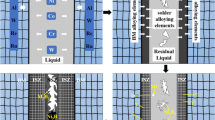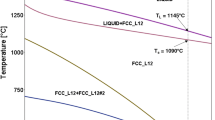Abstract
A new material for boron-free brazing of nickel-based superalloys is described that utilizes a transient liquid-phase bonding (TLPB) mechanism. Commercially available AMS 4764 powder (52.8Cu–37.5Mn–9.7Ni) was mixed with pure Ni powder to increase Ni content in the filler metal. This alloy is a good candidate for TLPB in Ni superalloy applications because of its high strength, low liquidus temperature, low cost and the absence of brittle intermetallic phases. Analysis of in situ braze joint formation with IN625 base metal using differential scanning calorimetry measurements allowed for optimization of Ni content, braze temperature and hold time conditions of the brazing process. Calculated ternary phase diagrams coupled with EDS analysis of braze joints identified a low-temperature copper-rich segregated region in braze joints, which, through interdiffusion with the base metal, increases melting temperature with increasing hold time. This work concludes that a 50-µm half braze joint can be formed through full isothermal solidification with an 80-min hold at 1050 °C. Solidification occurs primarily through interdiffusion of base metal and filler metal.















Similar content being viewed by others
References
Macdonald WD, Eagar TW (1992) Transient liquid phase bonding. Annu Rev Mater Sci 22:23–46
Cook GO, Sorensen CD (2011) Overview of transient liquid phase and partial transient liquid phase bonding. J Mater Sci 46:5305–5323. https://doi.org/10.1007/s10853-011-5561-1
Henhoeffer T, Huang X, Yandt S, Seo DY, Au P (2009) Microstructure and high temperature tensile properties of wide gap brazed cobalt based superalloy X-40 and IN738. Mater Sci Technol 25:840–850
Henhoeffer T, Huang X, Yandt S, Au P (2011) Fatigue properties of narrow and wide gap braze repaired joints. J Eng Gas Turbines Power 133:92101
Heinz P, Volek A, Singer RF, Dinkel M, Pyczak F, Göken M, Ott M, Affeldt E, Vossberg A (2008) Diffusion brazing of single crystalline nickel base superalloys using boron free nickel base braze alloys. Defect Diffus Forum 273–276:294–299
Dinkel MK, Heinz P, Pyczak F, Volek A, Ott M, Affeldt E, Vossberg A, Göken M, Singer RF (2008) New boron and silicon free single crystal-diffusion brazing alloys. In: Proceedings of the international symposium on superalloys, pp. 211–220
Ruan ZC, Wang SC, Zhang XR (1996) Microstructure and bonding behavior of a new Hf-bearing interlayer alloy for single crystal nickel-base superalloy. Scr Mater 34:163–168
Miglietti W, Du Toit M (2009) High strength, ductile braze repairs for stationary gas turbine components—part 2. In: Proceedings of ASME turbo expo 2009: power for land, sea and air. ASME, Orlando, Florida, pp 903–914
Miglietti W, Du Toit M (2008) High strength, ductile braze repairs for stationary gas turbine components—part 1. In: Proceedings of ASME turbo expo 2008: power for land, sea and air. ASME, Berlin, Germany, pp 501–513
Zheng Y, Zhao L, Tangri K (1993) Microstructure of Ni–10Co–8Cr–4W–13Zr alloy and its bonding behaviour for single-crystal nickel-base superalloy. J Mater Sci 28:823–829. https://doi.org/10.1007/BF01151264
Huang X (2014) Brazing of CMSX4 with a boron- and silicon-free Ni–Co–Zr–Hf–Cr–Ti–Al brazing alloy. Weld J 93:233–243
Laux B, Piegert S, Rösler J (2009) Braze alloy development for fast epitaxial high-temperature brazing of single-crystalline nickel-based superalloys. Metall Mater Trans A Phys Metall Mater Sci 40:138–149
Laux B, Rösler J (2010) Development of Ni–Mn-based alloys for the fast epitaxial braze-repair of single-crystalline nickel-based superalloys. Int J Mater Res 101:614–622
Ghasemi A, Pouranvari M (2019) Fast isothermal solidification during transient liquid phase bonding of a nickel alloy using pure copper filler metal: solubility vs diffusivity. Met And Mater Trans A 50A:2235–2245
AWS C3 Committee on Brazing and Soldering (eds) (2007) Brazing handbook, 5th edn. American Welding Society, Miami
Sun W, Xu H, Du Y, Liu S, Chen H, Zhang L, Huang B (2009) Experimental investigation and thermodynamic modeling of the Cu–Mn–Ni system. Calphad Comput Coupling Phase Diagrams Thermochem 33:642–649
Bazhenov VE, Pikunov MV (2010) Temperature minimum line in the Cu–Ni–Mn phase diagram. Steel Transl 40:225–228
Bazhenov VE (2013) Phase diagram of the Cu–Ni–Mn system. Russ J Non Ferrous Met 54:49–55
Murray DC, Corbin SF (2017) Determining the kinetics of transient liquid phase bonding (TLPB) of inconel 625/BNi-2 couples using differential scanning calorimetry. J Mater Process Technol 248:92–102
Moreau ED, Corbin SF (2020) Initial boron uptake and kinetics of transient liquid phase bonding in Ni-based superalloys. Met Mater Trans A. https://doi.org/10.1007/s11661-020-05724-1
Miettinen J (2003) Thermodynamic description of the Cu–Mn–Ni system at the Cu–Ni side. Comput Coupling Phase Diagr Thermochem 27:147–152
Andersson JO, Helander T, Höglund L, Shi PF, Sundman B (2002) Thermo-calc and DICTRA, computational tools for materials science. Calphad 26:273–312
MacIsaac MC (2019) Development of a novel boron free filler metal for transient liquid phase bonding of Ni based superalloys. MASc Thesis, Dalhousie University, Nova Scotia, Canada, pp 222–269
Acknowledgements
The authors would like to thank the Natural Science and Engineering Research Council of Canada (NSERC) and Pratt and Whitney Canada for their financial support of this research. They thank Liv MacLellan for performing some of the braze preparations, DSC and metallography experiments. They would also like to thank Alain Bouthillier, Francesco D’Angelo, Thomas Georges and Orlando Scalzo of Pratt and Whitney Canada for their guidance, fruitful discussions and support of this work. Additional thanks to Paul Mason for assistance with Thermo-Calc software.
Author information
Authors and Affiliations
Corresponding author
Ethics declarations
Conflict of interest
The authors declare that they have no conflict of interest.
Additional information
Publisher's Note
Springer Nature remains neutral with regard to jurisdictional claims in published maps and institutional affiliations.
Rights and permissions
About this article
Cite this article
MacIsaac, C., Whitman, C.A. & Corbin, S.F. Development of a boron-free filler metal for brazing nickel-based superalloys utilizing the Cu–Mn–Ni system. J Mater Sci 55, 8741–8755 (2020). https://doi.org/10.1007/s10853-020-04594-7
Received:
Accepted:
Published:
Issue Date:
DOI: https://doi.org/10.1007/s10853-020-04594-7




